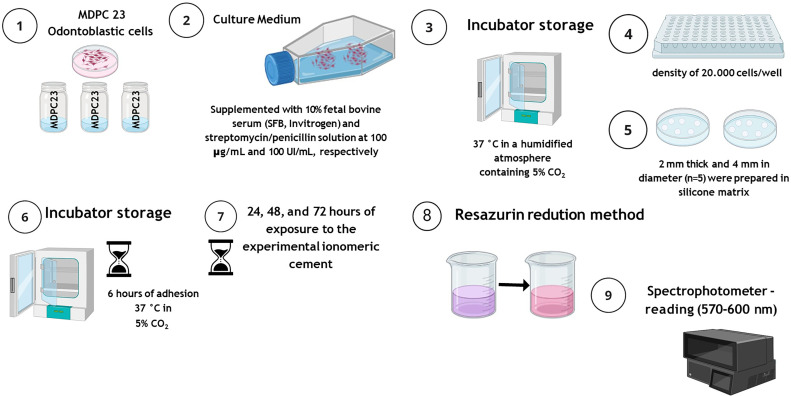Phosphorylated chitosan and nano-sized TMP: enhancing strength, antibiofilm action, and biocompatibility of restorative glass ionomer cements.
PIATI, Gabrielle Cristina; SILVA, Danielly Beatriz Gonçalves; DELBEM, Alberto Carlos Botazzo; MARTORANO, Antonio Secco; RAUCCI, Larissa Moreira Spinola de Castro; OLIVEIRA, Paulo Tambasco de; ZUCOLOTTO, Valtencir; DIAS, Bruna Juliana Moreira; BRIGHENTI, Fernanda Lourenção; OLIVEIRA, Analú Barros de; MORAES, João Carlos Silos; CAMARGO, Emerson Rodrigues de; VIDILLI, André Luiz; DANELON, Marcelle.
PIATI, Gabrielle Cristina; SILVA, Danielly Beatriz Gonçalves; DELBEM, Alberto Carlos Botazzo; MARTORANO, Antonio Secco; RAUCCI, Larissa Moreira Spinola de Castro; OLIVEIRA, Paulo Tambasco de; ZUCOLOTTO, Valtencir; DIAS, Bruna Juliana Moreira; BRIGHENTI, Fernanda Lourenção; OLIVEIRA, Analú Barros de; MORAES, João Carlos Silos; CAMARGO, Emerson Rodrigues de; VIDILLI, André Luiz; DANELON, Marcelle.





 Abstract: Objectives Evaluated the effect of phosphorylated chitosan (ChiPh) and nano-sized sodium trimetaphosphate (TMPnano) incorporation into resin modified glass ionomer cement (RMGIC) on mechanical, fluoride release, antimicrobial and cytotoxic properties. Methods RMGIC was combined with ChiPh (0.25 %/0.5 %) and/or TMPnano (14 %). The diametral compressive/tensile strength (DCS/TS), surface hardness (SH) and degree of conversion (%DC) were determined. For fluoride (F) release, samples were immersed in DE/RE solutions. Antimicrobial/antibiofilm activity was evaluated by agar diffusion test/biofilm metabolism. Cytotoxicity on MDPC-23 odontoblast cell lines was evaluated. Results TS and DCS (24 h), all the groups were similar (p > 0.05). After 7 days, RMGIC-14 %TMPnano-0.25 %ChiPh showed the best results for TS/DCS (p < 0.05). The SH was lower and similar for the RMGIC and RMGI-14 %TMPnano-0.5 %ChiPh groups (p > 0.05) after 24 h; after 7 days, all groups containing TMPnano and/or ChiPh showed higher SH when compared to RMGIC, except for RMGIC-0.5 % ChiPh. The %DC was similar for all groups (p = 0.172). There was a gradual release of F for all groups during the 15 days; in the cumulative analysis, after 15 days, the RMGIC-14 %TMPnano-0.25 %ChiPh group showed the highest value (p < 0.05). Viability against S. mutans was observed for the RMGIC-14 %TMPnano-0.25 %ChiPh group (p < 0.05). After 24 h, the RMGIC-0.25 %ChiPh and RMGIC-14 %TMPnano-0.25 %ChiPh groups showed the lowest cytotoxic effect (p = 0.371); at 48 h/72 h, only the RMGIC-14 %TMPnano-0.25 %ChiPh group showed similar cytocompatibility. Conclusion The addition of ChiPh (0.25 %) and TMPnano (14 %) improved the RMGIC's mechanical, antimicrobial/antibiofilm and cytotoxic properties. Clinical relevance
Abstract: Objectives Evaluated the effect of phosphorylated chitosan (ChiPh) and nano-sized sodium trimetaphosphate (TMPnano) incorporation into resin modified glass ionomer cement (RMGIC) on mechanical, fluoride release, antimicrobial and cytotoxic properties. Methods RMGIC was combined with ChiPh (0.25 %/0.5 %) and/or TMPnano (14 %). The diametral compressive/tensile strength (DCS/TS), surface hardness (SH) and degree of conversion (%DC) were determined. For fluoride (F) release, samples were immersed in DE/RE solutions. Antimicrobial/antibiofilm activity was evaluated by agar diffusion test/biofilm metabolism. Cytotoxicity on MDPC-23 odontoblast cell lines was evaluated. Results TS and DCS (24 h), all the groups were similar (p > 0.05). After 7 days, RMGIC-14 %TMPnano-0.25 %ChiPh showed the best results for TS/DCS (p < 0.05). The SH was lower and similar for the RMGIC and RMGI-14 %TMPnano-0.5 %ChiPh groups (p > 0.05) after 24 h; after 7 days, all groups containing TMPnano and/or ChiPh showed higher SH when compared to RMGIC, except for RMGIC-0.5 % ChiPh. The %DC was similar for all groups (p = 0.172). There was a gradual release of F for all groups during the 15 days; in the cumulative analysis, after 15 days, the RMGIC-14 %TMPnano-0.25 %ChiPh group showed the highest value (p < 0.05). Viability against S. mutans was observed for the RMGIC-14 %TMPnano-0.25 %ChiPh group (p < 0.05). After 24 h, the RMGIC-0.25 %ChiPh and RMGIC-14 %TMPnano-0.25 %ChiPh groups showed the lowest cytotoxic effect (p = 0.371); at 48 h/72 h, only the RMGIC-14 %TMPnano-0.25 %ChiPh group showed similar cytocompatibility. Conclusion The addition of ChiPh (0.25 %) and TMPnano (14 %) improved the RMGIC's mechanical, antimicrobial/antibiofilm and cytotoxic properties. Clinical relevance @article={003240650,author = {PIATI, Gabrielle Cristina; SILVA, Danielly Beatriz Gonçalves; DELBEM, Alberto Carlos Botazzo; MARTORANO, Antonio Secco; RAUCCI, Larissa Moreira Spinola de Castro; OLIVEIRA, Paulo Tambasco de; ZUCOLOTTO, Valtencir; DIAS, Bruna Juliana Moreira; BRIGHENTI, Fernanda Lourenção; OLIVEIRA, Analú Barros de; MORAES, João Carlos Silos; CAMARGO, Emerson Rodrigues de; VIDILLI, André Luiz; DANELON, Marcelle.},title={Phosphorylated chitosan and nano-sized TMP: enhancing strength, antibiofilm action, and biocompatibility of restorative glass ionomer cements},journal={Journal of Dentistry},note={v. 156, 105675-1-105675-12, May 2024.},year={2025}}
@article={003240650,author = {PIATI, Gabrielle Cristina; SILVA, Danielly Beatriz Gonçalves; DELBEM, Alberto Carlos Botazzo; MARTORANO, Antonio Secco; RAUCCI, Larissa Moreira Spinola de Castro; OLIVEIRA, Paulo Tambasco de; ZUCOLOTTO, Valtencir; DIAS, Bruna Juliana Moreira; BRIGHENTI, Fernanda Lourenção; OLIVEIRA, Analú Barros de; MORAES, João Carlos Silos; CAMARGO, Emerson Rodrigues de; VIDILLI, André Luiz; DANELON, Marcelle.},title={Phosphorylated chitosan and nano-sized TMP: enhancing strength, antibiofilm action, and biocompatibility of restorative glass ionomer cements},journal={Journal of Dentistry},note={v. 156, 105675-1-105675-12, May 2024.},year={2025}}